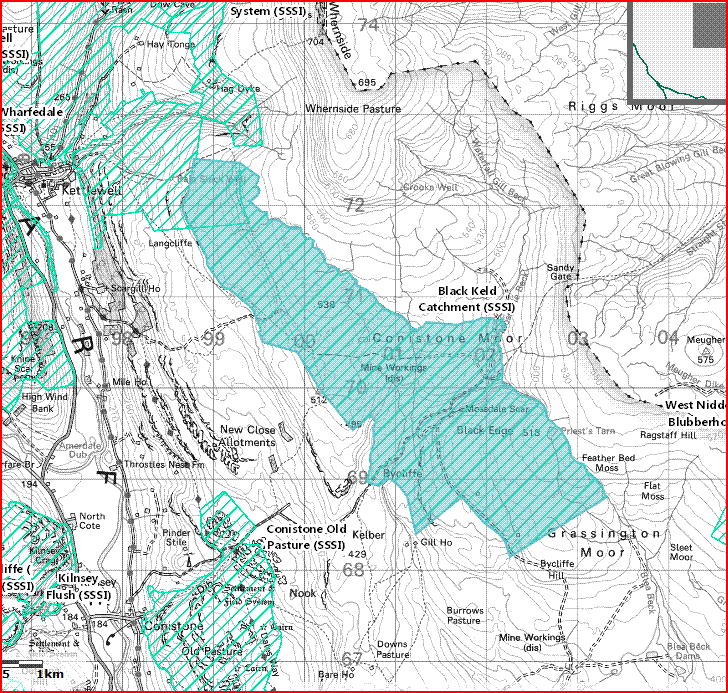THE MOSSDALE CATCHMENT AREA: with Permission from NATURAL ENGLAND
Date Notified: 16 February 1999
County: North Yorkshire Site Name Black Keld Catchment Area
Status: Site of Special Scientific Interest (SSSI) notified under Section 28 of the Wildlife and
Countryside Act, 1981. (as amended)
Local Planning Authority: North Yorkshire County Council, Yorkshire Dales National Park,
Craven District Council
National Grid Reference: SE 010700
Ordnance Survey Sheet 1:50,000: 98 1:10,000: SD 96 NE, SD 97 SE, SE 06 NW, SE 07 SE, SW
Area: 1401.3 (ha) 3461.21 (ac)
First Notified: 16 February 1999
Description and Reasons for Notification:
The site covers an extensive area of Conistone Moor and Grassington Moor to the south-west of Great Whernside and approximately 6 km north of Grassington. Two major cave systems, Langcliffe Pot and Mossdale Caverns are present and together, these caverns consist of over 20 kilometres of passages. The underground drainage system which feeds the stream resurgence at Black Keld is one of the largest and deepest in Britain, although only a small proportion of its cave passages are accessible at present.
The system is unique in that the cave drainage is constrained initially within the Yoredale Limestones, but then breaks through into the underlying Great Scar Limestone, resurging about 160 m below at Black Keld close to the base of the limestone succession. These cave systems therefore breach the intervening shales and sandstones which normally act as aquicludes. These breaches are a response to geological controls, and result from the penetration of stream ways through open tectonic fissures, small faults, major fractures, and zones where the Middle Limestone and Great Scar Limestone have been brought into lateral contact with each other through displacement along faults. Drainage within the vadose zone of the cave system is constrained by the south-easterly dip of the limestones, however, the resurgence of Black Keld lies to the north-west of the sinks of either cave system.
The patterns of passages in both Langcliffe Pot and Mossdale Caverns are unusual for cave systems within the Yoredale Limestones, and Mossdale Caverns has a divergent branching pattern which resembles the pattern of a phreatic maze in its complexity, and as such, the caverns are regarded as important examples of maze caves.
Other Information:This is a Geological Conservation Review Site:
Explanatory Geological Note:
The purpose of this note is to describe the nature an importance of the site, avoiding specialist terms, for the site owner and/or occupier. This note does not form part of the formal notification documents.
Black Keld Catchment Area, North Yorkshire:The cave system occupies an area of approximately 1400 hectares on Conistone Moor and
Grassington Moor, about 6 kilometres north of Grassington. Two major cave systems,
Langcliffe Pot in the north and Mossdale Caverns in the south, together comprising 21
kilometres of explored passages underlie this area.
Water enters Mossdale Caverns where Mossdale Beck sinks at Mossdale Scar. From there it
follows a complex sequence of passageways in a general south-easterly direction, eventually
disappearing beyond chokes or blockages. Water enters Langcliffe Pot through several sinks
and again follows a south-easterly route. Again, the passageways become blocked.
The placing of marker dyes in waters of these two systems has demonstrated that the water
emerges at the resurgence of Black Keld in the floor of Wharfedale Ð to the north and east of
the two cave systems and in a direction almost opposite that of the stream flow within the
caves. In addition, the limestone bed in which the resurgence is located in geological strata
approximately 280 metres below the strata the sinks reside in. The rocks surrounding the
caves consist of alternating layers of limestone, shale and sandstone. The caves passages are
developed in the limestones where water passing through cracks in the limestone has
dissolved the limestone and over a long period of time, opened the cracks into passages.
Neither the shales or the sandstones are susceptible to dissolution by water, nor will they
easily allow the passage of water through them. As the shales and sandstones intervene
between the limestone bands, water should not be able to penetrate through this succession of
rocks. Black Keld Catchment area clearly demonstrates the effect that geological structure
can have on the development of cave systems.
The rocks over much of the area dip to the south-east and the cave passages have an overall
trend in this direction. The cave streams have broken through the shales and sandstones along
weakened zones that were fractured because the rocks had been displaced by faults. Two of
these faulted zones may be seen in Langcliffe Pot where the stream has broken through the
shales and sandstones and entered a lower layer of limestone. Faults have also been
responsible for displacing different layers of limestone and bringing them in contact with each
other, by passing the shales and sandstones in between.
Black Keld Catchment Area is of importance in demonstrating the effects of geological
structure on the development of a cave system.
